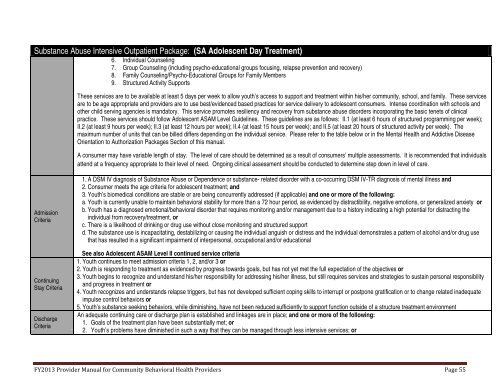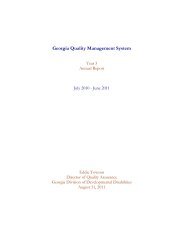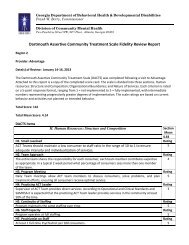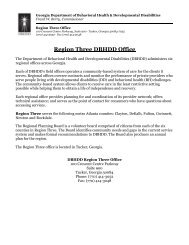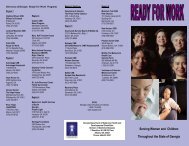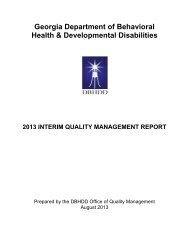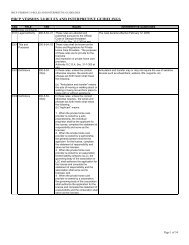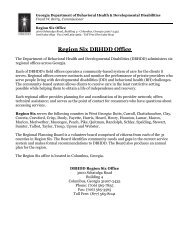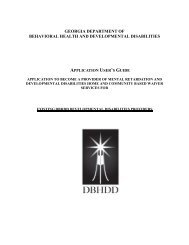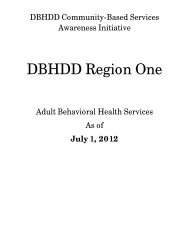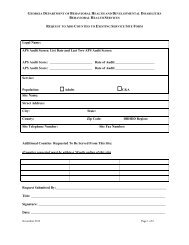PART I - Department of Behavioral Health and Developmental ...
PART I - Department of Behavioral Health and Developmental ...
PART I - Department of Behavioral Health and Developmental ...
Create successful ePaper yourself
Turn your PDF publications into a flip-book with our unique Google optimized e-Paper software.
Substance Abuse Intensive Outpatient Package: (SA Adolescent Day Treatment)6. Individual Counseling7. Group Counseling (including psycho-educational groups focusing, relapse prevention <strong>and</strong> recovery)8. Family Counseling/Psycho-Educational Groups for Family Members9. Structured Activity SupportsThese services are to be available at least 5 days per week to allow youth’s access to support <strong>and</strong> treatment within his/her community, school, <strong>and</strong> family. These servicesare to be age appropriate <strong>and</strong> providers are to use best/evidenced based practices for service delivery to adolescent consumers. Intense coordination with schools <strong>and</strong>other child serving agencies is m<strong>and</strong>atory. This service promotes resiliency <strong>and</strong> recovery from substance abuse disorders incorporating the basic tenets <strong>of</strong> clinicalpractice. These services should follow Adolescent ASAM Level Guidelines. These guidelines are as follows: II.1 (at least 6 hours <strong>of</strong> structured programming per week);II.2 (at least 9 hours per week); II.3 (at least 12 hours per week); II.4 (at least 15 hours per week); <strong>and</strong> II.5 (at least 20 hours <strong>of</strong> structured activity per week). Themaximum number <strong>of</strong> units that can be billed differs depending on the individual service. Please refer to the table below or in the Mental <strong>Health</strong> <strong>and</strong> Addictive DiseaseOrientation to Authorization Packages Section <strong>of</strong> this manual.A consumer may have variable length <strong>of</strong> stay. The level <strong>of</strong> care should be determined as a result <strong>of</strong> consumers’ multiple assessments. It is recommended that individualsattend at a frequency appropriate to their level <strong>of</strong> need. Ongoing clinical assessment should be conducted to determine step down in level <strong>of</strong> care.AdmissionCriteriaContinuingStay CriteriaDischargeCriteria1. A DSM IV diagnosis <strong>of</strong> Substance Abuse or Dependence or substance- related disorder with a co-occurring DSM IV-TR diagnosis <strong>of</strong> mental illness <strong>and</strong>2. Consumer meets the age criteria for adolescent treatment; <strong>and</strong>3. Youth’s biomedical conditions are stable or are being concurrently addressed (if applicable) <strong>and</strong> one or more <strong>of</strong> the following:a. Youth is currently unable to maintain behavioral stability for more than a 72 hour period, as evidenced by distractibility, negative emotions, or generalized anxiety orb. Youth has a diagnosed emotional/behavioral disorder that requires monitoring <strong>and</strong>/or management due to a history indicating a high potential for distracting theindividual from recovery/treatment, orc. There is a likelihood <strong>of</strong> drinking or drug use without close monitoring <strong>and</strong> structured supportd. The substance use is incapacitating, destabilizing or causing the individual anguish or distress <strong>and</strong> the individual demonstrates a pattern <strong>of</strong> alcohol <strong>and</strong>/or drug usethat has resulted in a significant impairment <strong>of</strong> interpersonal, occupational <strong>and</strong>/or educationalSee also Adolescent ASAM Level II continued service criteria1. Youth continues to meet admission criteria 1, 2, <strong>and</strong>/or 3 or2. Youth is responding to treatment as evidenced by progress towards goals, but has not yet met the full expectation <strong>of</strong> the objectives or3. Youth begins to recognize <strong>and</strong> underst<strong>and</strong> his/her responsibility for addressing his/her illness, but still requires services <strong>and</strong> strategies to sustain personal responsibility<strong>and</strong> progress in treatment or4. Youth recognizes <strong>and</strong> underst<strong>and</strong>s relapse triggers, but has not developed sufficient coping skills to interrupt or postpone gratification or to change related inadequateimpulse control behaviors or5. Youth’s substance seeking behaviors, while diminishing, have not been reduced sufficiently to support function outside <strong>of</strong> a structure treatment environmentAn adequate continuing care or discharge plan is established <strong>and</strong> linkages are in place; <strong>and</strong> one or more <strong>of</strong> the following:1. Goals <strong>of</strong> the treatment plan have been substantially met; or2. Youth’s problems have diminished in such a way that they can be managed through less intensive services; orFY2013 Provider Manual for Community <strong>Behavioral</strong> <strong>Health</strong> Providers Page 55


